It’s time for another sketchbook tour, this one will cover the sketches I completed in the spring of 2022.
One thing I’m noticing about my sketchbook work recently is that I’m drawing slowly and with more intent, and that I’m focusing more on each subject. From a naturalist standpoint, I welcome this, it means I learn more about what I draw and I’m more likely to identify a species when I see it again. I simply have a better point of reference. From an artistic standpoint, I also enjoy to spend more time on each sketch. The process feels less stressed, and I feel more comfortable with letting pencil drawings stand on their own. I don’t feel like I have to finish a whole page in one sitting. Maybe it also has to do with the long course on Sketching Fundamentals that I put together – this let me really focus on producing better drawings and understanding the drawing process (teaching is such a great way to revisit one’s habits and processes).
So I’m creating less pages but I like each individual page more. I like the challenge to make each page work from a design standpoint, and this slower pace allows me to unwind (and actually rediscover my sketchbook as a way to let go of stress).
Of course, this means I likely have a few less pages to share in each sketchbook tour. Let’s see what I put together in the last few months:
I really focused on botanical sketches this spring, and finding the right colors for the delicate spring violets and blues can be a challenge. I put together different violet spring flowers on the left page, and combined this with a slightly loose, bolder landscape sketch on the right. I added colored pencil on top of my washes to define the stones in the foreground. Also take a look at this vivid green of the bear garlic on the top, it is really this green, but it reminds me of all the convenience greens I threw out of my palette.
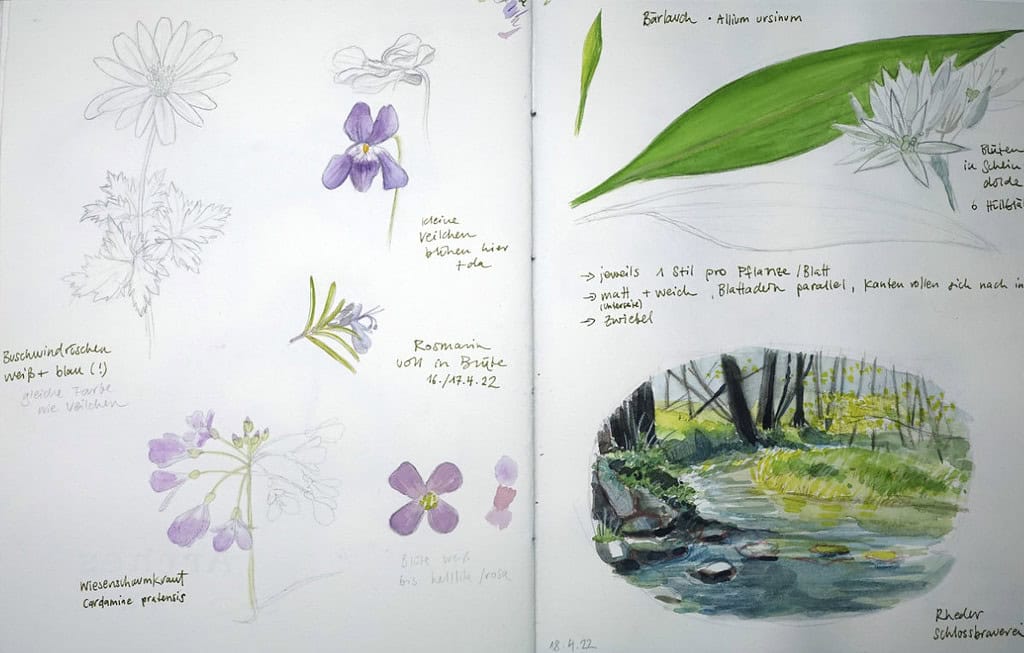
A collection of spring impressions – new beech and ash leaves, a bird’s nest in a tree hole, the first butterfly of the year, and spring plants like woodruff and cowslip. I’ve started to experiment with inked linework here.
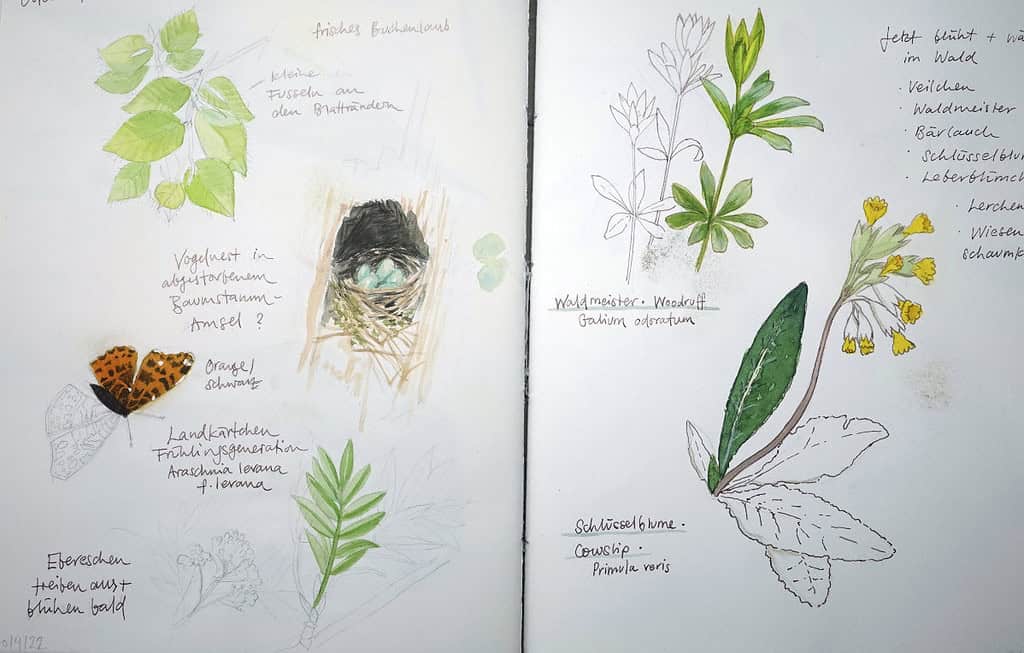
More plants studies – liverwort and an interesting fern (maidenhair spleenwort) we found on the stone walls of a derelict castle. I already shared my painting of the apple blossom in a previous video, below you can see the landscape the tree belonged to.

A study page of goats (always endearing to watch) and peregrine falcon feet. I realized I need more practice with bird’s feet.

I’ve already shared a video about this particular page of orchid sketches, these are early purple orchids that were in their prime back at the beginning of May. Sketching this page also prompted my recent palette changes.
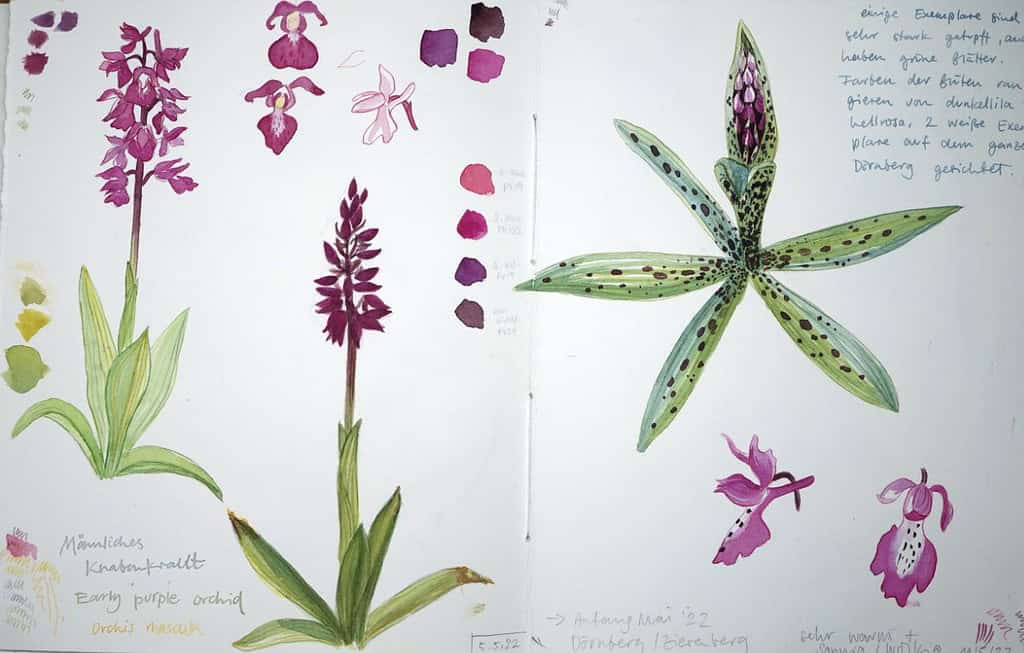
A more relaxed page of all the other plants and animals I encountered during my orchid hunt – snowdrop anemone, lorraine flax, a special kind of veronica and snails and lizards. I didn’t get round to really finish this page, so it looks a bit empty on the right. Maybe over time some notes will follow.
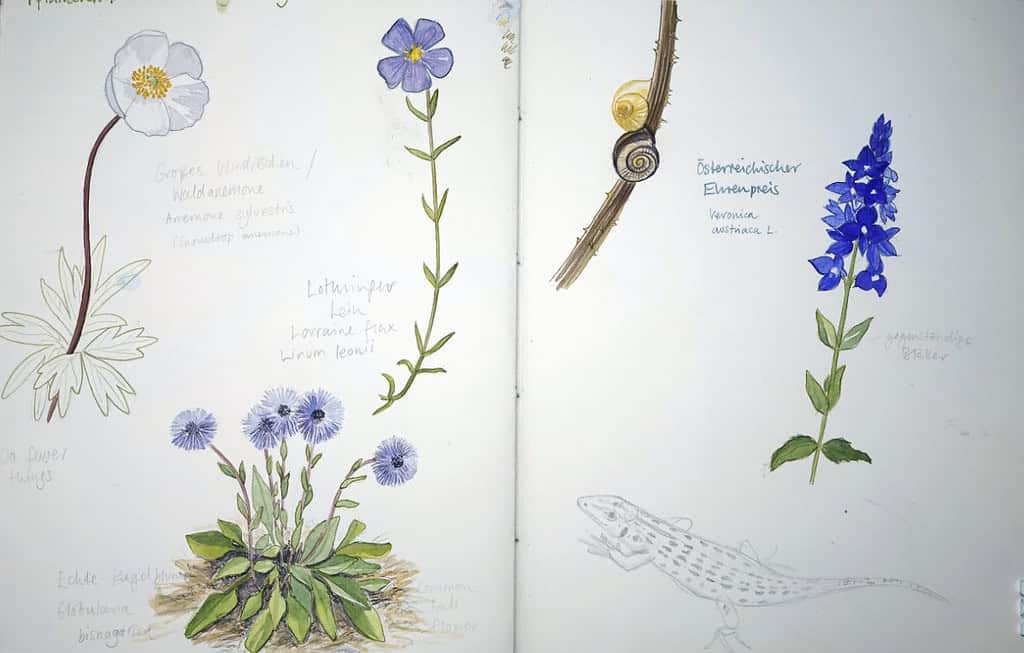
Another sketching outing in a nature reserve, this time no orchids at all, but other interesting plants like catsfoot and lots of beautiful grasses. It was a very hot day, so I ended up sketching a landscape in the shade, and took lots of photos so I could finish the rest at home.
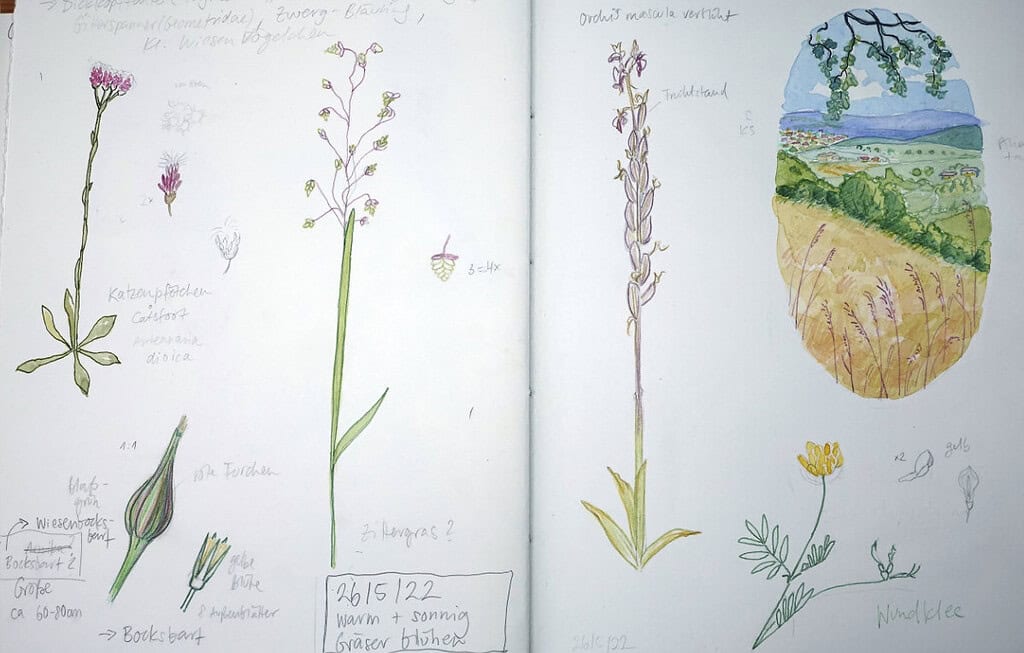
There were few butterfly species in the same area, and I sketched some of them. I mostly worked from photographs, because it was a) too hot to sit in the meadow and sketch on that day, and b) there are hardly any butterflies left. The sketch below might look like a plentiful selection of species, but it is not. Meadows, especially in these calciferous grassland areas on sunny days, used to crawl and flutter with all kinds of insects a few years back, and it was no problem to just sit down and watch them. Now they’re almost all gone, even in protected areas (that are usually surrounded by land that is used for intensive farming and almost ecologically dead). Since insects are an important part of the food chain and life cycle for all kinds of other species, this is alarming.
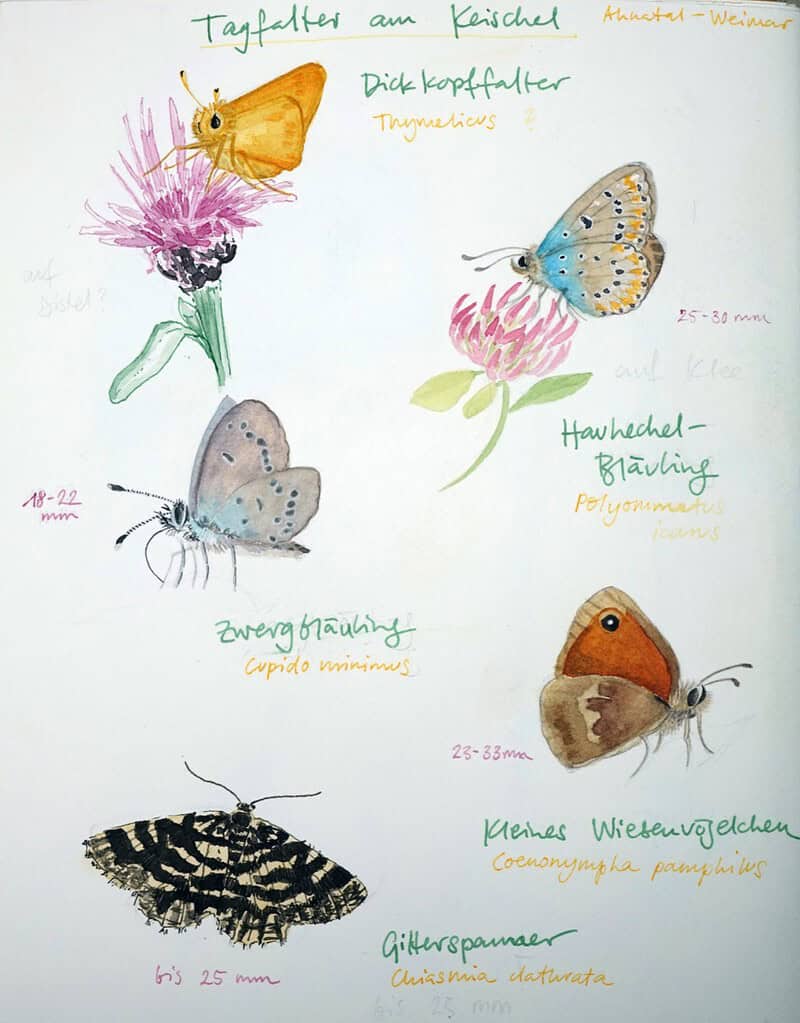
This effect, as far as I can observe it and as many others have put it into a scientific view (read about the Krefeld study here or in more scientific detail here), has been going on for a few decades now, but it is still depressing every time to see it with your own eyes. It is a sign that we are indeed quickly destroying biodiversity together with a livable climate for ourselves. The loss of species and of habitats will become more painful and apparent in the coming years. This likely won’t get better, since our capitalist economy is based on exploiting nature as a “free resource” and maximizing profits means grabbing these resources, exploiting people and destroying nature along the way.
I’m now beginning to think that all I’m doing here is documenting the loss of biodiversity on a small scale. Even in the long run, you won’t really see or feel this loss, because no-one notices when species disappear from an area, and it doesn’t seem crucial or important enough. Yet biodiversity is one of the keys for keeping our ecosystems healthy and livable.
It is a defeating thought, but on the other hand I can’t stop to notice and study nature, even if it is disappearing and being destroyed by the awful system we’re living in. I usually only share the beautiful aspects of my journeys in nature, but I’m beginning to think maybe I need to change that too, in order to keep it in all our consciences what we are part of, and what will happen if we don’t put a stop to it.
Anyway. In June I started a new sketchbook, and I took it with me on the next orchid hunt adventure. Another day spent on the lookout for these rare beauties. I counted no less than six different orchid species:
- Common Twayblade/Großes Zweiblatt (Neottia ovata)
- Fly orchid/Fliegenragwurz (Ophrys insectifera)
- Flagrant orchid/Große Händelwurz (Gymnadenia conopsea)
- Greater Butterfly-orchid/Grünliche Waldhyazinthe (Platanthera chlorantha)
- Lady Orchid/Purpur-Knabenkraut (Orchis purpurea)
- Three-toothed orchid/Dreizähniges Knabenkraut (Neotinea tridentata)
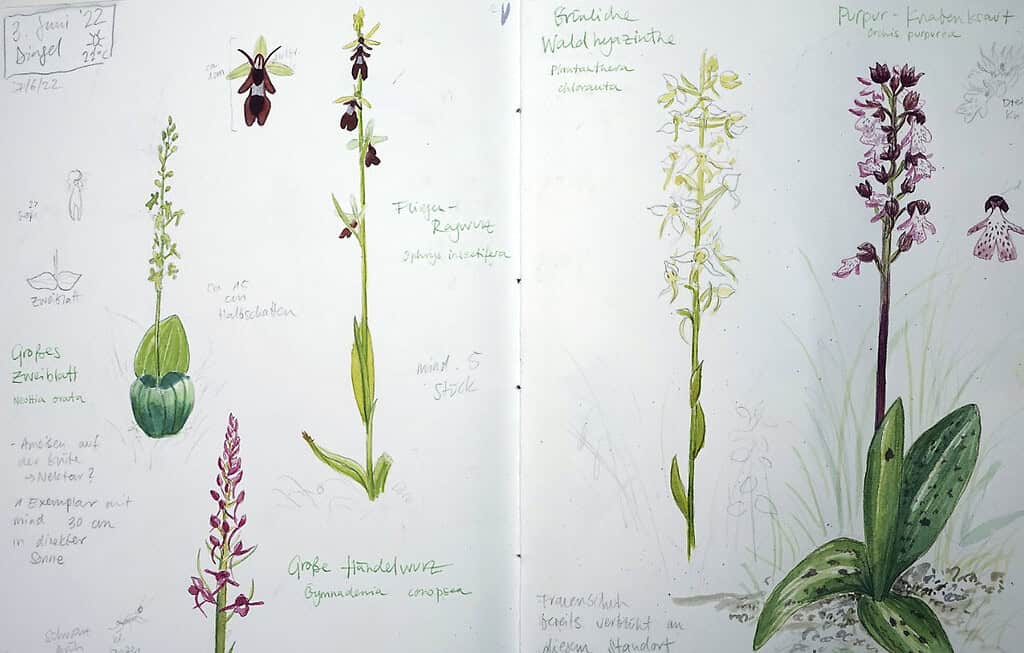
Again, as in all other areas I’ve visited so far not many butterflies or other insects were present, but for a while I was in the company of two talkative ravens. I painted some of the orchids in the field and the rest at home due to the extreme heat.
I keep experimenting how I can bring my mixed-media approach to my field sketches without carrying too many tools. Right now, I bring two fountain pens (pink and green) to get clean outlines for the plants on top of my pencil sketch, since I kept misplacing colored pencils I will need to find a different solution for those. I’m constantly reorganizing my kit these days as I’m trying to keep it minimal yet also fitting to my way of sketching.
This is all for now, I have a few more pages I want to show you in detail, maybe as a video (I’m a bit burnt out from making videos right now, and I try to spend as much time as possible outside and not in front of a computer). As I said, right now I’m enjoying working in this slower pace, rediscovering my tools and drawing process, and I hope that the results are still of interest to you.
Thank you for following along! What are you sketching right now? How is the nature and the insect population doing where you live?
Thank you for reading this blog! It'll always stay free. To keep it going, you can support my work directly through a donation or through my nature sketching classes.
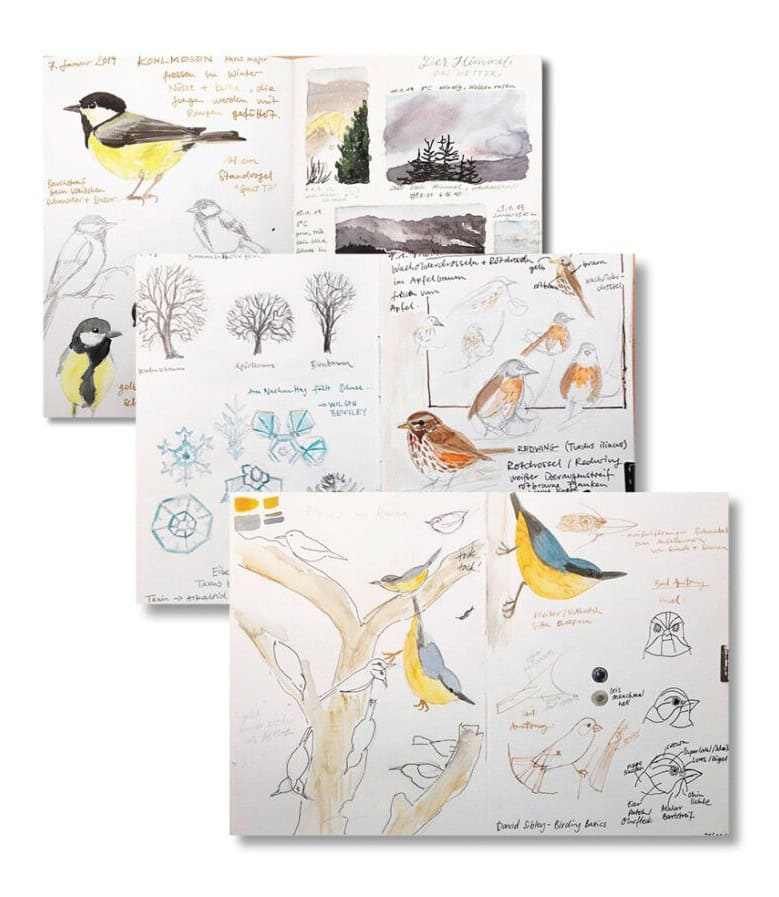
Join my free newsletter and never miss a blog post! You'll get new blog post notifications directly to your inbox. Receive 5 great sketching resources as a welcome gift for joining my newsletter! Here's what's inside:
- How to draw anything (PDF guide)
- Getting started with watercolor (free ebook)
- My favorite tips for creating great sketchbook pages
- My 5-step guide for drawing birds (PDF guide)
- My current watercolor palette layout (PDF guide)
By subscribing, you agree that I may process your information in accordance with my privacy policy

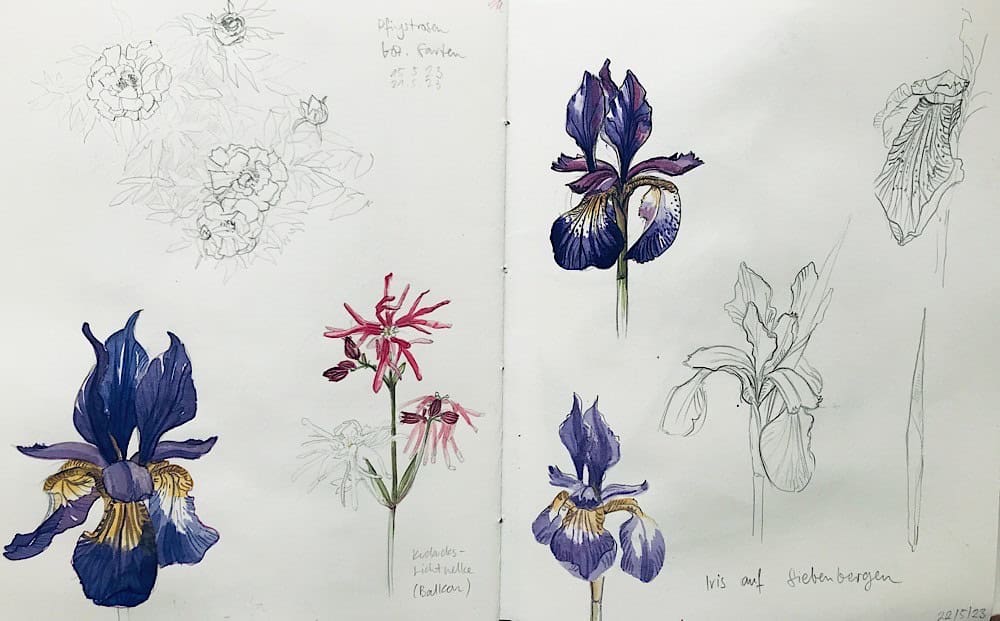
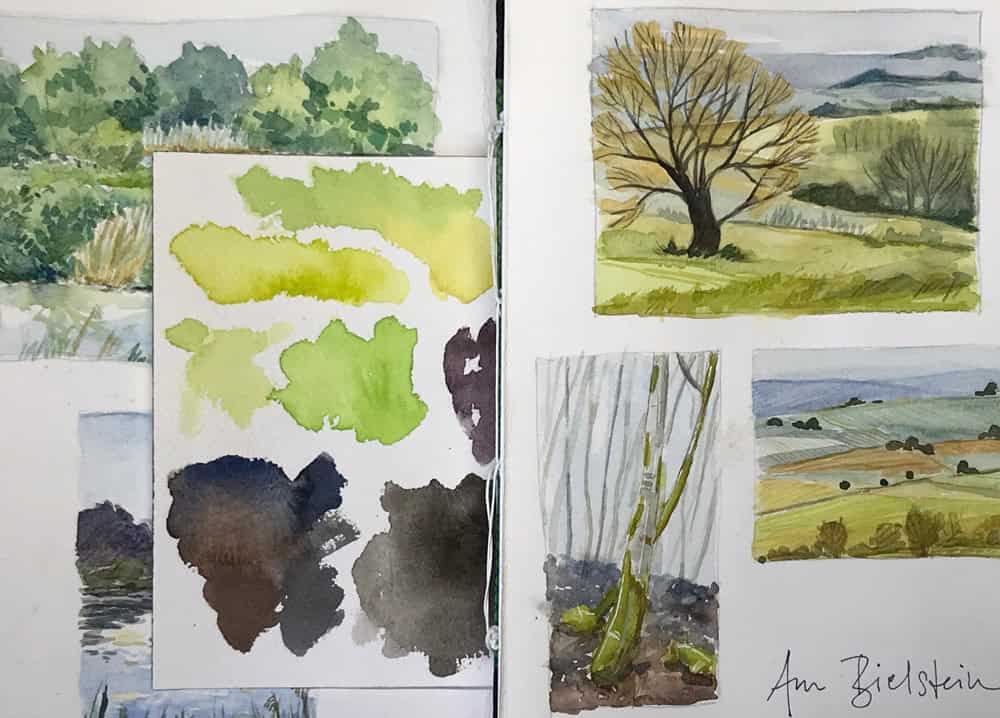
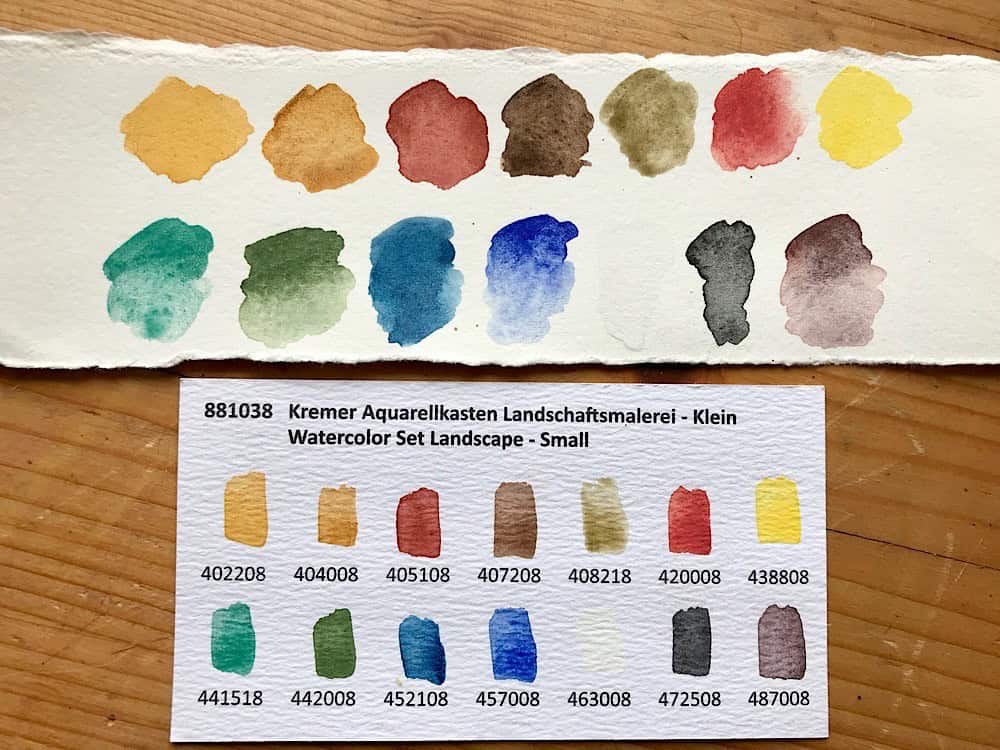
How interesting and beautiful Julia! It’s a lot of work, I’d have envoyef watching you work.
I understand you make your botanical sketches mostly in the field, but do you also collect samples or take pictures to the studio? Sorry, I’m not trying to check on your behaviour, sometimes I collect them too.
Thank you very much Juan! I actually also do a lot of botanical (and wildlife) drawings in the studio (for client work, personal projects, etc.), so field sketching is a welcome change of pace and the foundation of the rest. I do take a lot of pictures, sometimes I use references from others, but I still try to draw from life a lot. If it’s a common species (like a weed or field flower), I will take a sample back home, of course with very rare and protected plants (like the orchids I showed) that’s not possible. So for these it’s either field sketching or taking good photos!
Thank you Julia! I’ve just been watching some of your videos in youtube (orchids, apple tree blossom, starting fear at sketching …) They are great and I hope you will keep the good work!
About the watercolour technique I noticed you use a wet brush instead of a dry brush technique, am I right? Is it intentioned? Any comment on this? Thank you!
I definitely will make videos again when I have the time and energy. 🙂
I use different techniques, for field sketching I generally have a more loose style with more water. I find that painting outside (plus filming while doing it) presents its own challenges, and in order to keep it fun I don’t use the same meticulous, precise dry brushing technique that I often use for illustration work. Field sketching for me is also moving around, exploring, taking visual notes if you will. I hope that makes sense!
Yes, thank you!
Very interesting. We are starting to see more butterflies in the last couple of years. We have dug a large pond and have let milk weed flourish in our yard to encourage wildlife.
Oh that sounds wonderful Patricia. I’m sure the pond and the wildflowers are helping the local wildlife a lot!
I really enjoyed your landscape paintings this visit, it’s always nice to picture the view along with the flowers, birds, and insects you share. And I could feel the serenity and joy in each little landscape. I tend to do small things like that in my sketchbook as well. I appreciated how you mentioned slowing down and focusing a little more. Thank you for the sketchbook peek!
Thank you so much Jennifer! I really enjoy these small landscapes and they’re not too overwhelming to finish – always an important aspect for me.
Nature journaling is a great way for citizen scientists to record the diversity at the time of writing. Thank you for sharing your thoughts and talents.
I love those little landscape drawings – they look like a window into a hidden world and give a great context of where those plants and animals live.
Do you have a class on how to draw landscapes? I have always felt intimidated with that topic and have not really tried my hand at it yet. Yours always look so lovely – not too detailed but giving a nice feel of the place.
Also love the look of the ink sketches – want to invest in some waterproof inks in softer colors and give it a go!
Thank you for taking us along on your nature adventures!
Dear Ayoka, thank you so much! There is an introduction to drawing landscapes in my Sketching Fundamentals class with the most important basics explained, and I’m already planning and writing a small landscape sketching class including watercolor techniques. But it needs a bit more time until it’s finished.
Enjoy exploring inks! I always dilute my inks a bit when they are too intense, it works with most of them. 🙂
Julia – love your spring pages. Your skill at capturing nature is lovely. Hope you have a great day.
Thank you so much Debora! 🙂
Julia- thank you for yet more beautiful images of the natural world. I also have notice that there are fewer insects, more empty flowers. It is so disheartening. I had stopped sketching because of the grief of it, but that did not help as I must be out in nature regardless of how it is. Thanks for inspiring me to begin again.
Gabrielle (from the Sonoran desert in Arizona)
I completely understand you, Gabrielle. It is all disheartening and I often question my motivation for making art. Maybe we can discover the beautiful moments again through sketching, the moments and things that haven’t disappeared yet. All my best wishes!